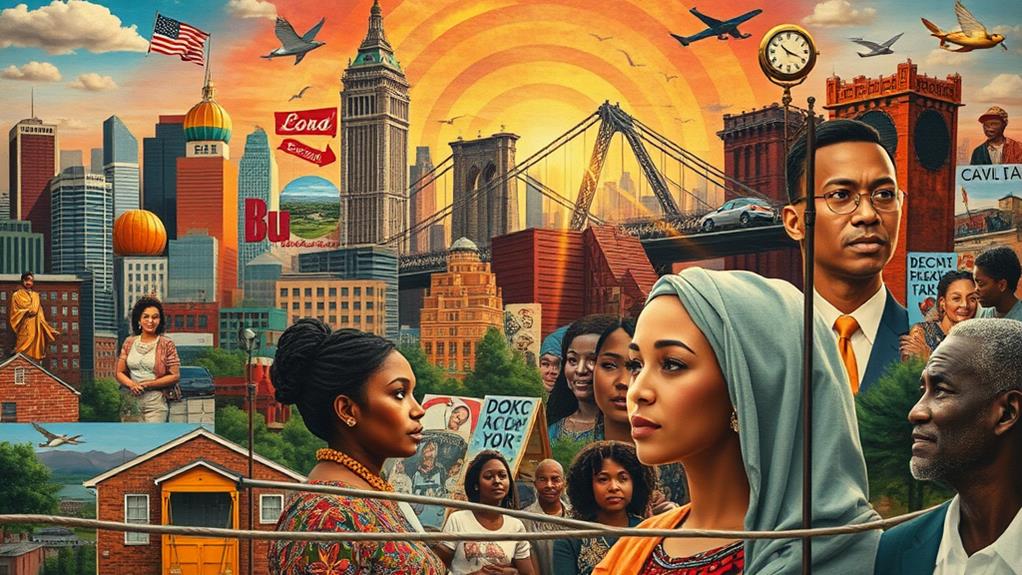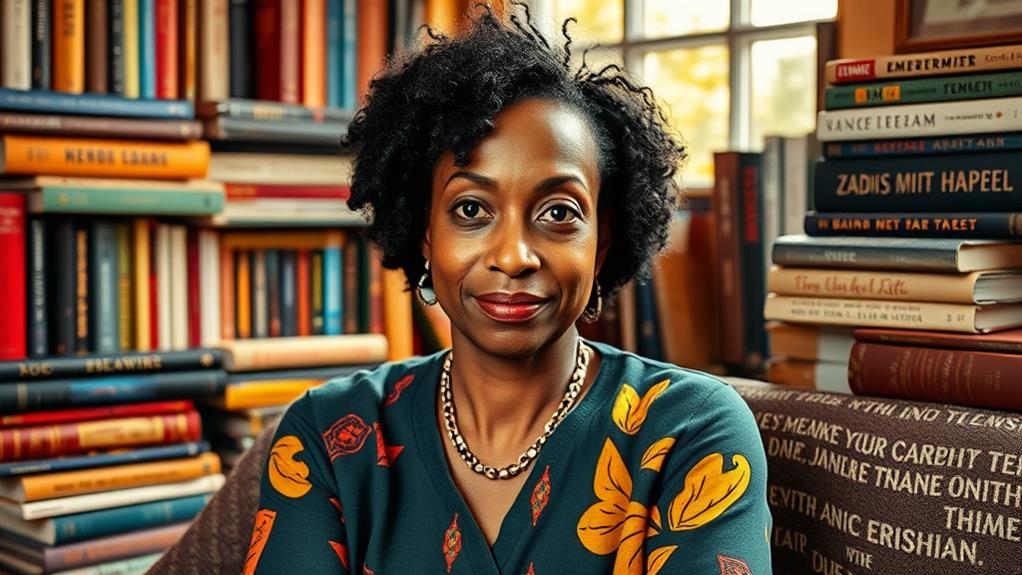Zadie Smith's "On Beauty" follows the Belsey family, a diverse clan grappling with love, identity, and cultural strife in modern America. You'll meet Howard, a liberal arts professor whose infidelity complicates family ties, and Kiki, who battles societal expectations about beauty. Their children face their own challenges: Jerome struggles with faith, Zora navigates activism, and Levi seeks belonging. The novel cleverly mixes humor with serious themes, exploring race and class tensions, all while echoing classic literature's resonance. If you want to uncover deeper insights into these characters and their dilemmas, keep exploring the layers of this brilliant narrative.
Overview of the Novel
Zadie Smith's "On Beauty" immerses you in the lives of the Belsey family, skillfully weaving themes of family, identity, and cultural conflict. Set in the fictional town of Wellington, Massachusetts, this novel explores the complexities of an interracial family maneuvering their own dynamics against a backdrop of societal expectations.
You meet Howard and Kiki Belsey, whose relationship is tested by professional rivalries and personal struggles, particularly in their interactions with the Kipps family. The novel's exploration of love, class struggles, and personal growth resonates with the enduring themes found in classic literature such as the resilience of the human spirit portrayed in Charles Dickens' works.
As you probe deeper into the narrative, you witness how the Belsey family's experiences reflect broader issues of race and beauty in contemporary society. Smith's sharp wit and humor highlight the absurdities of academic life while offering a critique of prevailing norms.
The Belsey family's journey isn't just about individual identity; it's also about how cultural conflict shapes their relationships and perspectives.
With its rich character development and insightful commentary, "On Beauty" stands as Zadie Smith's third novel, earning critical acclaim, including a shortlist for the Man Booker Prize and the Orange Prize for Fiction.
This multifaceted exploration of identity and family resonates long after you turn the last page.
Character Profiles
In Zadie Smith's novel, the Belsey family dynamics reveal the complexities of love and betrayal that shape their lives.
As they maneuver their relationships, the interactions echo the historical context and societal expectations of marriage, where traditional roles often dictate personal choices.
Each character confronts unique cultural identity challenges while maneuvering academic rivalry, particularly Howard's fraught relationship with Monty Kipps.
This struggle reflects the ongoing power dynamics in marriage the complexities of marriage.
As you explore their stories, you'll see how personal struggles intertwine with broader societal issues, creating a rich tapestry of human experience.
Family Dynamics Explored
Exploring the intricate dynamics of the Belsey family reveals a tapestry of conflicting identities and expectations. At the center, you have Howard, a liberal arts professor whose infidelity with Claire Malcolm shatters the family's foundation.
Kiki, his wife, grapples with her feelings of betrayal and societal beauty standards, struggling to reclaim her sense of self amidst the turmoil.
Jerome, the eldest son, navigates heartbreak and a crisis of faith at Brown University. His relationship with Victoria Kipps complicates his loyalty to his family, reflecting the push and pull of identity that haunts him.
Zora, the middle child, emerges as a passionate activist. Disillusioned by her father's actions, she fiercely seeks her own identity while wrestling with issues of race and gender, keenly aware of the impact of her family's legacy.
Levi, the youngest, faces his own challenges as he investigates Haitian nationalism. His quest for belonging and authenticity showcases the generational struggle within the Belsey family.
Each character's journey highlights how family dynamics shape their identities, revealing the complex interplay between personal aspirations and familial expectations.
Cultural Identity Challenges
Often, the characters in Zadie Smith's novel grapple with their cultural identities as they navigate the complexities of their family dynamics.
Jerome Belsey, the eldest son in an interracial family, struggles to align his Christian faith with his relationship with his girlfriend, Victoria Kipps. His journey reflects the broader challenges of balancing personal beliefs with cultural expectations.
Zora Belsey, the middle child, asserts her individuality as an activist at Wellington University, yet her father's infidelity and her own insecurities complicate her quest for authenticity.
Meanwhile, Levi Belsey, the youngest son, faces his own trials as he interacts with Haitian nationalists and becomes involved in the theft of Monty's painting. This act represents his struggle for authentic self-expression amid external influences.
Kiki Belsey, as an African American woman, confronts societal pressures surrounding beauty and race, grappling with her self-worth in light of her husband's infidelity.
The arrival of Monty Kipps, representing a conservative British-Caribbean identity, further intensifies cultural tensions. His presence challenges the Belsey family's liberal views, adding layers to their ongoing exploration of cultural identity and belonging.
Academic Rivalry Tensions
Amid the complexities of cultural identity, academic rivalries add another layer of tension in Zadie Smith's novel. The rivalry between Howard Belsey, a liberal professor, and Monty Kipps, a conservative scholar, drives much of the plot. Howard's passion for Rembrandt clashes with Monty's conservative beliefs, creating a competitive atmosphere at Wellington College that challenges Howard's professional reputation and personal integrity.
As their tensions escalate, several key elements come to the forefront:
- Howard's affair with Claire Malcolm deepens the conflict, affecting both families.
- Monty's arrival forces Howard to confront his insecurities and failures.
- The rivalry highlights broader cultural and ideological divides in academia.
- Jerome Belsey and Victoria Kipps, the families' children, become unwitting participants in the feud.
- The personal and professional fallout complicates their relationships and identities.
Through this academic rivalry, Smith illustrates the complexities of ideological divides and the impact of familial ties. The dynamics between Howard and Monty not only serve as a driving force in the narrative but also reflect the intricate interplay of personal relationships within the academic landscape.
Key Themes

In Zadie Smith's novel, you'll find a rich exploration of family dynamics, especially how infidelity strains relationships within the Belsey family.
This narrative, much like the courage and determination to overcome challenges found in Unbreakable Non-Fiction Tales of Survival and Hope, reflects the complexities of human connections and the resilience required to navigate them.
You'll also see the challenges of cultural identity as the characters navigate their diverse backgrounds and the impact on their connections.
These themes not only drive the narrative but also invite you to reflect on your own experiences with family and identity.
Family Dynamics Explored
Family dynamics in Zadie Smith's novel are a complex tapestry woven with themes of betrayal, identity, and the clash of ideals. The Belsey family maneuvers through the treacherous waters of Howard's infidelity, which strains their relationships, particularly Kiki's connection with their children: Jerome, Zora, and Levi.
Each family member grapples with their own struggles, reflecting a generational divide that complicates understanding and loyalty.
- Jerome's conversion to Christianity and romance with Victoria Kipps underscores the clash of personal beliefs and family ties.
- Zora's activism demonstrates her disappointment in her father's choices, revealing differing values within the family.
- Levi faces challenges of identity and cultural belonging, reflecting the pressures of race and class.
- The rivalry between the Belsey and Kipps families serves as a catalyst for conflict, demonstrating how political ideologies can fracture familial bonds.
These elements create a rich narrative that explores how love and loyalty are tested within the framework of modern family dynamics.
In maneuvering through these complexities, Smith reveals the fragility and resilience of familial relationships, inviting readers to reflect on their own connections.
Cultural Identity Challenges
Cultural identity challenges shape the lives of the Belsey family in Zadie Smith's "On Beauty," revealing the intricate interplay between race, personal beliefs, and societal expectations. Kiki navigates the pressures of beauty and loyalty, especially during her husband's infidelity, struggling to maintain her sense of self amid societal expectations. Her journey highlights the racial differences that complicate her identity within both her family and the broader community.
Zora Belsey embodies the quest for authenticity, engaging in activism while wrestling with her father's liberal ideals and his personal shortcomings. This tension illustrates the generational clash in understanding cultural identity.
Meanwhile, Levi Belsey seeks belonging through friendships with Haitian nationalists, reflecting the complexities of race and personal experience as he searches for acceptance.
The rivalry between the Belseys and the Kipps family underscores how cultural and racial differences shape familial relationships and individual identities, particularly in an academic setting.
Smith critiques societal expectations and stereotypes, especially through Carl's humorous philosophical views, which challenge conventional standards of beauty, love, and attraction. In this rich narrative, the Belsey family confronts the challenges of cultural identity in profound and revealing ways.
Notable Quotes
Zadie Smith's "On Beauty" is rich with notable quotes that capture the essence of its characters and themes. These lines not only resonate with the individuals in the story but also reflect broader societal issues, particularly around loyalty, family dynamics, and beauty norms.
The exploration of these themes can be likened to the resilience showcased in Louis Zamperini's survival story, emphasizing the strength of the human spirit in confronting adversities. Additionally, Smith's narrative touches upon the ethical complexities of personal relationships, reminiscent of the historical injustices discussed in the ethical dilemmas in medical research.
Here are some standout quotes that encapsulate these ideas:
- "The greatest lie ever told about love is that it sets you free." – Kiki's struggle with loyalty amidst Howard's infidelity is profound.
- "Fat ladies need love too." – Carl challenges societal beauty norms, reminding us that love transcends physical appearance.
- "It was in the air, or so it seemed to Kiki." – This reflects her awareness of the pervasive societal hatred towards women.
- "You can never know when you're being betrayed." – Zora's realization highlights the personal betrayals that deeply affect family dynamics.
- "Monty saw his chance and took it." – This quote succinctly captures the competitive academic culture that fuels conflict between the Belsey and Kipps families.
Through these quotes, Zadie Smith weaves a narrative that explores complex themes with wit and insight, making "On Beauty" a truly engaging read.
Author Background

Born in London to a Jamaican mother and an English father, Smith's background considerably shapes her exploration of race and identity in her novels. As a British author, Zadie Smith brings a unique perspective to contemporary literature, addressing the complexities of multiculturalism and belonging.
Her debut novel, "White Teeth," published in 2000, garnered widespread acclaim and set the stage for her career. It won several awards, showcasing her ability to weave race and identity into compelling fiction. Much like Charles Dickens in exploring social class and its impact, Smith investigates the nuances of identity within diverse cultural landscapes.
In 2005, she published "On Beauty," which further solidified her status as a significant voice in literature. This novel earned her the James Tait Black Memorial Prize and the Orange Prize for Fiction, reflecting her skill in tackling intricate social issues while maintaining a witty narrative style.
Beyond her novels, Smith's essays in reputable publications like The New Yorker and The Guardian demonstrate her engagement with current cultural conversations, making her a notable figure not just in fiction but in broader discourse.
Currently, she's a tenured professor of fiction at New York University, influencing the next generation of writers and thinkers while continuing to explore the themes of race and identity in her work.
Critical Reception
With its sharp wit and engaging narrative, "On Beauty" quickly garnered critical acclaim upon its release. Zadie Smith's novel not only captivated readers but also critics, earning a spot on the shortlist for the Man Booker Prize and winning the prestigious Orange Prize for Fiction.
This recognition underscores its significant impact on contemporary literature.
Critics praised various elements of the book:
- The New York Times commended its focus on personal relationships.
- The Guardian highlighted Smith's wit and originality.
- Publishers Weekly described it as a superb and funny novel, emphasizing character development.
- Kirkus Reviews pointed out the sharp satire on superficial beauty, critiquing societal norms.
Reader reviews show mixed feelings about pacing, with an average rating of 3.77 from over 84,000 ratings.
Cultural Commentary

Exploring societal expectations through its characters, "On Beauty" critiques the often superficial nature of beauty, particularly through Kiki Belsey's struggle with her identity amidst external pressures.
Zadie Smith dives deep into cultural identity, showcasing how race and class shape individual experiences within the Belsey and Kipps families. This exploration resonates with themes found in works like systemic racism and identity, as both authors confront the complexities of societal influences on personal identity.
The humor woven throughout the narrative serves as a sharp lens, satirizing the elitism prevalent in academia, especially through Howard Belsey's misguided views on art and value.
Smith artfully illustrates family dynamics, where personal relationships are entangled with broader political ideologies. Characters grapple with authenticity, revealing the complexities of their identities as they navigate a rapidly changing societal landscape.
The clash between the Belseys and the Kipps highlights the cultural tensions that arise from differing backgrounds, prompting you to reflect on how societal expectations influence one's self-perception.
As you read, you can't help but appreciate Smith's ability to tackle these themes with wit and insight, making "On Beauty" not just a story about family, but a poignant commentary on the ever-evolving definitions of beauty and identity in the modern world.
Thematic Comparisons
Smith's exploration of societal expectations naturally leads to a comparison with E.M. Forster's "Howards End." Both novels investigate family dynamics and the intricate web of cultural identity, highlighting how these elements shape personal relationships.
Zadie Smith critiques societal norms surrounding beauty and privilege, reflecting on how her characters navigate these pressures in a racially diverse world, much like the unsung contributions in science that underscore the importance of recognizing diverse backgrounds and experiences.
Consider these thematic parallels:
- Family Dynamics: Both authors explore the complexities of familial relationships.
- Cultural Identity: Each novel examines how cultural background influences personal interactions.
- Academic Rivalry: Smith mirrors Forster's class tensions through the Belsey and Kipps families.
- Race and Identity: Both authors tackle issues of race, using humor to address serious themes.
- Love and Belonging: The search for belonging amidst societal expectations is central to both narratives.
Through these themes, "On Beauty" and "Howards End" illuminate the struggles between individual desires and societal pressures, allowing readers to reflect on their own identities within these frameworks.
Smith's wit and wisdom resonate with Forster's critique of human relationships, making both novels enduringly relevant.
Reading Experience

Zadie Smith's "On Beauty" offers readers a richly layered experience that can be both rewarding and demanding. As you immerse yourself in the narrative, you'll encounter a vast cast of characters traversing complex family dynamics that require your attention and investment.
The first 100 pages set a tone of tension and unease, immersing you in the Belsey family's struggles and the cultural contrasts that shape their lives. This exploration of identity and belonging resonates with themes of personal growth and resilience, highlighting how individuals can overcome challenges and find meaning in their experiences.
Jerome Belsey, a central character, becomes a relatable figure as he grapples with his relationships and personal identity amidst the chaos of family life. His journey invites you to reflect on your experiences, making the reading experience feel personal.
Smith expertly balances humor with serious themes, prompting you to think critically about societal issues while still finding moments of levity.
The novel's detailed writing and multiple perspectives enhance your engagement, providing insights into academic life, the complexities of beauty, and the intricacies of identity.
Conclusion
In Zadie Smith's insightful exploration, you'll discover the delicate dance of beauty and identity. Each character's quest reveals the complexity of culture and connection, inviting you to reflect. As you turn the pages, you'll savor the sharp wit and wisdom woven throughout. Ultimately, Smith's novel isn't just a story—it's a stimulating study that sparks thoughtful conversations about our perceptions. Immerse yourself, and let her lyrical language linger in your mind, enriching your understanding of beauty's boundless breadth.



